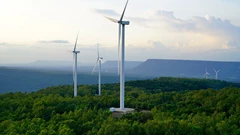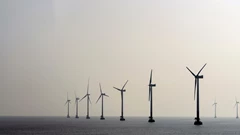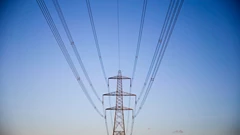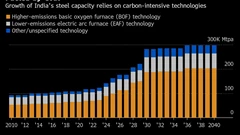China Remains as Reliant as Ever on Fossil Fuels
(Bloomberg) -- China remains as tied as ever to fossil fuels, even as it adds more renewable power than any other nation. Last year, the share of coal and gas in power generation was stuck at 71%, the same as 2020.
The world's biggest polluter wants to peak its carbon emissions by the end of the decade, and hit net-zero by 2060. But for all of the country's headway in expanding clean energy capacity, last year's economic growth of 8.1% basically meant that more output across all of its power sources was required to keep the lights on.
When it comes to power generation, which accounts for most of its emissions, China's on a treadmill that leaves it sprinting just to stand still. And the dirtiest fuel, coal, remains its main source of energy.

The unprecedented power crunch that struck in the second half of last year created its own demands. China's government was forced to raise both coal output and imports to record levels. The longer-term priority of switching from coal to natural gas meant that production and purchases of the cleaner-burning -- but still carbon-spewing -- alternative also rose to all-time highs.
Along with India, another coal-dependent economy, China pushed negotiators at November's COP26 climate talks to dilute a call to accelerate the phase-out of unabated coal power to a weaker pledge to phase-down use of fuel.
Thats not to say that the energy mix isn't changing. Growth in nuclear, wind and solar all outpaced the increase in total power generation, which was also at 8.1%. Only hydro disappointed, although that accounts for most of China's renewable power and additions are waning as the industry struggles to find suitable new locations for giant dams.

President Xi Jinping's grand ambitions to construct vast clean energy hubs in the nation's interior point to further growth in solar and wind in the years ahead. Almost as important will be a build-up in nuclear power that could include as many as 150 new reactors.
More stories like this are available on bloomberg.com
©2022 Bloomberg L.P.
KEEPING THE ENERGY INDUSTRY CONNECTED
Subscribe to our newsletter and get the best of Energy Connects directly to your inbox each week.
By subscribing, you agree to the processing of your personal data by dmg events as described in the Privacy Policy.
More renewables news

House Committee Says It Finds Evidence of ‘Climate Cartel’

WEC Energy Offered $2.5 Billion US Loan for Renewable Projects

With Trump Looming, Biden’s Green Bank Moves to Close Billions in Deals

GE Vernova Expects More Trouble for Struggling Offshore Wind Industry

Climate Tech Funds See Cash Pile Rise to $86 Billion as Investing Slows

GE Vernova to Power City-Sized Data Centers With Gas as AI Demand Soars

Longi Delays Solar Module Plant in China as Sector Struggles

Australia Picks BP, Neoen Projects in Biggest Renewables Tender

SSE Plans £22 Billion Investment to Bolster Scotland’s Grid
















